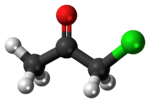Chloroacetone
 | |
 | |
| Names | |
|---|---|
| IUPAC name
Chloropropanone | |
| Other names
Acetonyl chloride, chloropropanone, 1-chloro-2-propanone, monochloroacetone, 1-chloro-2-ketopropane, 1-chloro-2-oxypropane UN 1695 | |
| Identifiers | |
| 78-95-5 | |
| 3D model (Jmol) | Interactive image |
| ChEBI | CHEBI:47220 |
| ChemSpider | 6323 |
| ECHA InfoCard | 100.001.056 |
| EC Number | 201-161-1 |
| PubChem | 6571 |
| RTECS number | UC0700000 |
| UNII | 60ZTR74268 |
| |
| |
| Properties | |
| C3H5ClO | |
| Molar mass | 92.52 g·mol−1 |
| Appearance | Colorless liquid, oxidizes to amber |
| Density | 1.123 g/cm3 |
| Melting point | −44.5 °C (−48.1 °F; 228.7 K) |
| Boiling point | 119 °C (246 °F; 392 K) |
| 10 g/100 mL at 20 °C | |
| Solubility | miscible in alcohol, ether, chloroform |
| Vapor pressure | 1.5 kPa |
| 2.36 | |
| Hazards | |
| Flash point | 35 °C (95 °F; 308 K) |
| 610 °C (1,130 °F; 883 K) | |
| Explosive limits | 3.4% - ?[1] |
| Lethal dose or concentration (LD, LC): | |
| LD50 (median dose) |
100 mg/kg (rats, oral)[2] |
| Except where otherwise noted, data are given for materials in their standard state (at 25 °C [77 °F], 100 kPa). | |
| | |
| Infobox references | |
Chloroacetone is a chemical compound with the formula CH3COCH2Cl. At STP it is a colourless liquid with a pungent odour.[3] On exposure to light, it turns to a dark yellow-amber colour.[4] It was used as a tear gas in World War I.[5]
Synthesis
Chloroacetone may be synthesized from the reaction between chlorine and diketene, or by the chlorination of acetone.
Applications
Chloroacetone is used to make dye couplers for colour photography, and is an intermediate in chemical manufacturing.[2] It is also used in the Feist-Benary synthesis of furans.[6]

Purification
Chloroacetone purchased from commercial suppliers contains 5% impurities including mesityl oxide, which is not removed by distillation. Mesityl oxide can be oxidized using acidified KMnO4 to form a diol (followed by separation with ether), which is removed on subsequent distillation.[7]
Transportation regulations
Transportation of unstabilized chloroacetone has been banned in the United States by the US Department of Transportation. Stabilized chloroacetone is in hazard class 6.1 (Poison Inhalation Hazard). Its UN number is 1695.
See also
References
- ↑ "ICSC:NENG0760 International Chemical Safety Cards (WHO/IPCS/ILO) CDC/NIOSH". Center for Disease Control. 2006-10-11. Retrieved 2009-04-17.
- 1 2 Hathaway, Gloria J.; Proctor, Nick H. (2004). Proctor and Hughes' Chemical Hazards of the Workplace (5 ed.). Wiley-Interscience. pp. 143–144. ISBN 978-0-471-26883-3. Retrieved 2009-04-16.
- ↑ "Occupational Safety and Health Guideline for Chloroacetone". U.S. Department of Labor - Occupational Safety & Health Administration. Retrieved 2008-06-06. External link in
|publisher=(help) - ↑ "CHLOROACETONE". International Programme on Chemical Safety. Retrieved 2008-06-06. External link in
|publisher=(help) - ↑ Haber, Ludwig Fritz (1986). The Poisonous Cloud: Chemical Warfare in the First World War. Oxford University press. ISBN 0-19-858142-4.
- ↑ Li, Jie-Jack; Corey, E. J. (2004). Name Reactions in Heterocyclic Chemistry. Wiley-Interscience. p. 160. ISBN 978-0-471-30215-5. Retrieved 2009-04-16.
- ↑ Phys. Chem. Chem. Phys., 2000,2, 237-245